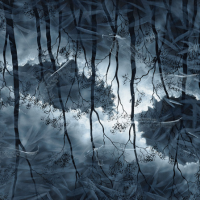26. LIN ONUS

Yorta Yorta artist Lin Onus was a master painter and political mastermind. Often masked by the beauty of their aesthetic thrall, his works are poetic and potent statements of Indigenous cultural authority.
Moonlight stems from a sublime, seemingly ethereal corpus depicting water bodies carefully contrived with technical virtuosity as interwoven layers of imagery, elements of which are sometimes, at least initially, obscured by reflected sky or reflected landscape, or both.
Depicting contradictory and ambivalent space was Onuss political forte. These works question narratives by challenging ones viewing position preconceptions and assumptionsin a transcendental aesthetic engagement about cultural hegemony. Within this paradigm, dreamlike visual effects operate to make transparency illusory and reality confused. Onuss nocturnes are particularly successful in this regard, wherein the obscured stands in for something other than the unseen: his understanding of what lies beneath the surface of things.1
In Moonlight, the central luminescence of the cloud-obscured moon transfixes at first, and then we glimpse life beneath the dark patches of inky water either side. In the shadowy depths, fish decorated with rarrk slip in and out of water weeds. Tracing the underwater dynamic, we are drawn around the edges of the canvas, searching. What else lies beneath? Stepping back, the upside-down tentacled trees reflected on the surface take command, their strong black verticals barricading the viewer from the world seen/unseen beyond ... reality check. And from this viewpoint back on terra firma, the central two patches of dark water suddenly come into focus and appear strangely mask-like but who, or what, is being masked?
Onuss deep connections to Arnhem Land and kinship with acclaimed artist Djiwul Jack Wunuwun (1930-1991) enriched his physical self and spiritual world view, and animated his mixed race/mixed cultural in-between space.2 It also heavily influenced his vision and optimism for his legacy, with hopes that history may see me as some sort of bridge between cultures 3
Onuss emphasis on reflection and water surface in his mature resolved work has been recently defined as a call for deep consideration of ones experience of life, or more specifically, to make connections between oneself and the world;4 a new narrative within and beyond the discourse and post-colonial imperative of decolonisation.
This thinking, and these works, are however no less interpolative than much of Onuss overtly satirical painted protests. Onuss declaration that there is no distinction between the political and the beautiful manifests itself in his watery landscapes, where ethical questions surface with deep aesthetic engagement.5 As one of the countrys most sought-after artists, and whose work has strong international appeal, Lin Onuss singular artistic legacy is enshrined.
Footnotes:
1. Lindsay, F., Lin Onus: Yinya Wala [exhib. cat.], Mossgreen, 2016, p.3
2. Levi-Strauss, quoted in Neale, M., Urban Dingo: The Art and Life of Lin Onus 1948-1996, Craftsman House in association with the Queensland Art Gallery, Brisbane, 2000, p.16. The in-between space has also been called the third space - an ambivalent space of cultural identity. See Bhabha, H. The Location of Culture, Routledge, London, 1994, pp.37-38
3. Lin Onus, quoted in Kleinert, S. & Neale, M., The Oxford Companion to Aboriginal Art and Culture, Oxford University Press, 2000, p.667
4. Sequeira, D., Lin Onus: Eternal Landscape [exhib. cat.], Margaret Lawrence Gallery, University of Melbourne, Melbourne, Victoria, 2019, p.31
5. This nexus in Indigenous art is considered at length in Ferrel, R., Sacred Exchanges: Images in Global Context, Columbia University Press, New York, 2012
Jane Raffan BA Hons. (Fine Arts); Grad. Dip. Environmental Law (Ethical Dealing Art & Cultural Heritage)